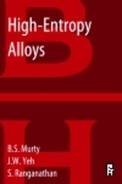Preface
Alloys traditionally have been based on a solvent element to which various solute atoms are added for improving specific properties. Thus, alloys are usually named after the major element in the alloy (e.g., Fe-, Al-, Cu-, Mg-, and Ni-base alloys). Two people, in recent times, have changed the way people look at alloys and they are Prof. Brian Cantor and Prof. Jien-Wei Yeh by coming up with equiatomic and nonequiatomic multicomponent alloys. Incidentally, though each of them started working on these alloys independently at different times (Cantor starting in 1979 and Yeh starting 1996), their work came to open literature in the same year, 2004. Interestingly, even before the papers of these two pioneers got published in 2004, Prof. S. Ranganathan felt the importance of this new class of alloys and wrote about them in his classic paper “Alloyed Pleasures: Multimetallic Cocktails” in 2003, which has been cited more than 100 times now as the first publication on this class of alloys.
Yeh christened these alloys as “high-entropy alloys (HEAs),” rightly so, as the configurational entropy of these alloys is expected to be very high at their random solution states. Such a high entropy is expected to drive the tendency to form simple solid solutions (crystalline or amorphous) rather than complex microstructures with many compounds. The concept has caught the attention of many researchers and the last one decade witnessed about 400–500 papers being published on HEAs with various elemental combinations. Two major observations can be made from all this work, namely, the alloys do form simple solid solutions in most of the cases and the number of phases observed in these alloys is much less than the maximum predicted from the Gibbs phase rule.
There are also clear indications that the high entropy in these multicomponent equiatomic and nonequiatomic alloys is not able to act like a glue holding all the atoms together in a single solid solution, and there are reports on the formation of two or more phases in which intermetallic phase formation and even segregation of certain elements were observed. This could be related with the various thermodynamic and kinetic factors. There has been intense activity in past few years to predict the phases that can form in such multicomponent alloys through various modeling approaches including integrated computational materials engineering (ICME) using various tools such as CALPHAD, ab-initio, molecular dynamics, Monte Carlo, and phase field approaches, which have been supported by materials genome initiative (MGI).
Besides the scientific curiosity, researchers also feel that HEAs can substitute conventional materials in advanced applications so that the limitations of the latter in service life and operational conditions could be overcome by providing superior performance of the former. A number of processing routes, including conventional melting and casting, mechanical alloying, various coating techniques, and even combinatorial materials science approaches are being used to synthesize and process this new class of alloys. There have been a lot of studies on understanding both the structural and functional properties of these alloys. The results of HEAs and HEA-related materials reported so far by various research groups are very encouraging for their applications in a wide range of fields such as materials for engine, nuclear plant, chemical plant, marine structure, tool, mold, hard facing, and functional coatings.
It is just over a hundred years since Walter Rosenhain wrote his seminal book on Physical Metallurgy. A century of research resulted in spectacular progress but the field became mature and the excitement began to wane. At the beginning of the third millennium, the discovery of High-Entropy Alloys has ushered in a renaissance in physical metallurgy.
This book presents a comprehensive insight into all the above aspects of this exciting new class of alloys. The book, being a short format one, is written keeping a beginner in the field in mind to give him/her an idea on various facets of HEAs that he/she can pursue.
